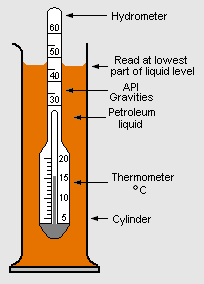API gravity
The API gravity is an arbitrary scale developed by the American Petroleum Institute (API) as a measure of the density of petroleum liquids at 60 °F (15.56 °C) relative to the density of water at 60 °F. The values of API gravity are expressed as degrees API and denoted as °API. The scale is calibrated such that most petroleum liquids will have API gravities between 10 and 70 °API.[1] The API gravity is inversely related to the density of the petroleum liquid which means that the higher is the API gravity, the lower is the liquid density.
The API gravity scale has been universally adopted and commonly used in the petroleum industry worldwide since the about 1921.
Relationship between API gravity and specific gravity
The relationship between API gravity and specific gravity (SG) of a petroleum liquid is mathematically expressed as:
- and where:
Conversely, the specific gravity may be obtained from the API gravity by this expression:
Petroleum liquids with an API gravity of more that 10 °API are lighter (i.e., have a lower density) than water and will float on water since petroleum liquids are immiscible in water. Petroleum liquids that are less than 10 °API are heavier (i.e., have a higher density) than water and will sink in water.
Measurement of API gravity
API gravity can be measured using an API hydrometer graduated with the API scale as per ASTM D-287, Standard Test Method for API Gravity of Crude Petroleum and Petroleum Products (Hydrometer Method).[2]
Alternatively, the density of the petroleum liquid may be measured at 60 °F may be determined and divided by the density of water at 60 °F to obtain the specific gravity of the liquid at 60 °F, which can then be converted to the °API using the equation in the previous section above.
History
Knowledge of relative density or specific gravity has been with us since the days of Archimedes in 250 BC, with the observation that light objects can float while heavier ones will sink in water.[3] Hypatia (born ca. 350 and died 415 AD), a Greek scholar from Alexandria in Egypt, is reputed to have invented the hydrometer.[4]
In 1675, hydrometers were developed by Robert Boyle, a British chemist and physicist. Around 1798, Antoine Baumé, a French scientist, designed the Baumé hydrometer scales for liquids both lighter and heavier than water.[5]
The relationship between °Bé and specific gravity at 20 °C for liquids lighter than water can be expressed as °Bé = (140/SG) – 130 where the 140 is referred to as the "modulus". However, it was discovered in 1881 that the modulus varied between 145.98 and 139.94 among the various manufacturers of Baumé hydrometers.[5]
Shortly after its formation in 1919, the API became involved in the study of petroleum measurement problems. In 1921, the API in conjunction with the U.S. Bureau of Mines and the U.S. Bureau of Standards recommended that any hydrometers used for petroleum measurement should have a scale based on the modulus of 141.5. Ever since then, such hydrometers have been known as API hydrometers, and the official designation of the hydrometer readings has been degrees API (°API).[5]
References
- ↑ Glossary From the website of the Argonne National Laboratory (ANL)
- ↑ ASTM D287] From website of the American Society for Testing and Materials (ASTM)
- ↑ T. L. Heath (1897). The Works of Archimedes. Cambridge University Press, page 253. Full text available at www.archive.org
- ↑ Mothers of Invention Ethlie Ann Vare and Greg Ptacek, 1988, pp. 24-26.
- ↑ Jump up to: 5.0 5.1 5.2 About API Gravity] From the website of the American Petroleum Institute



